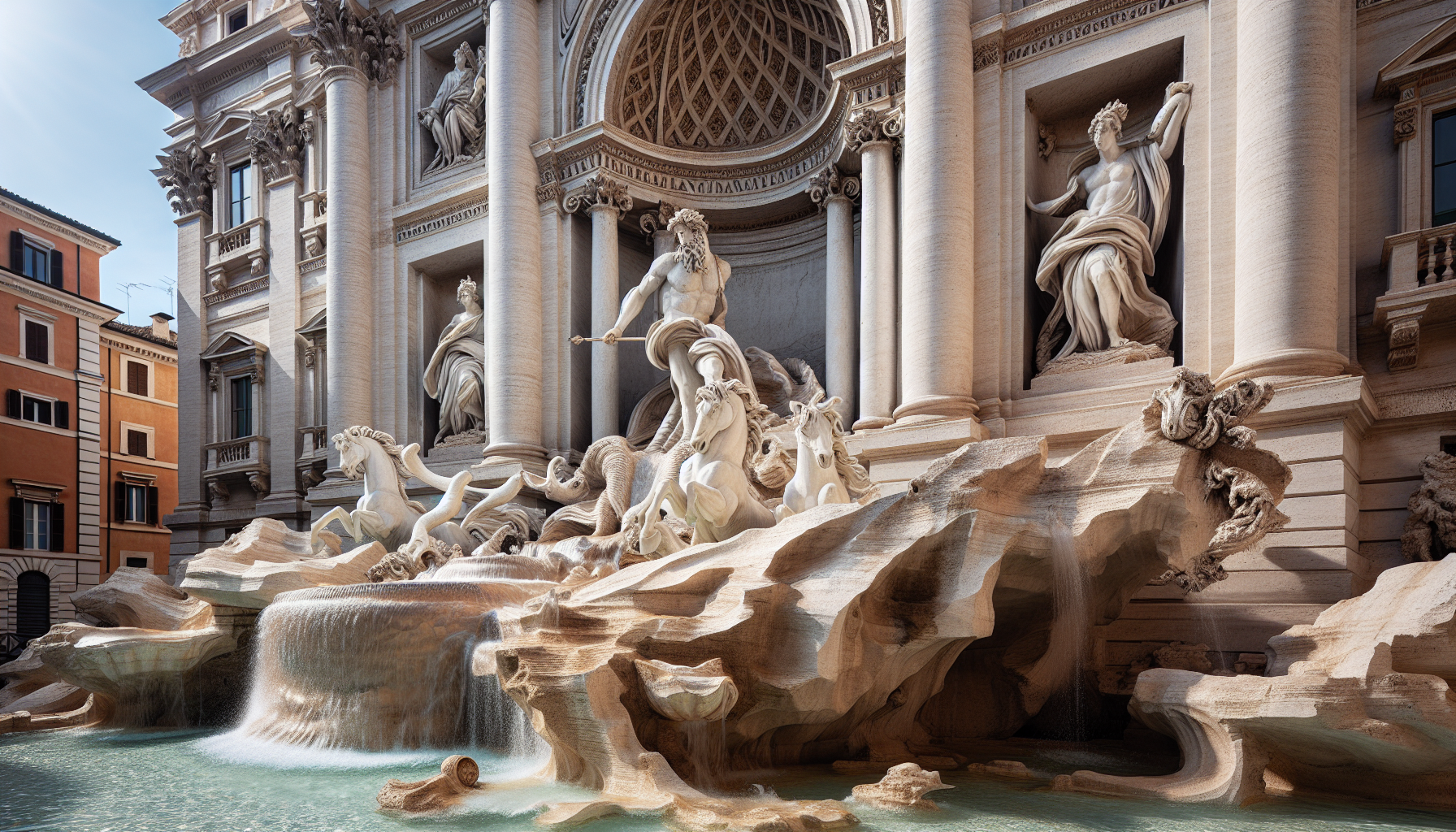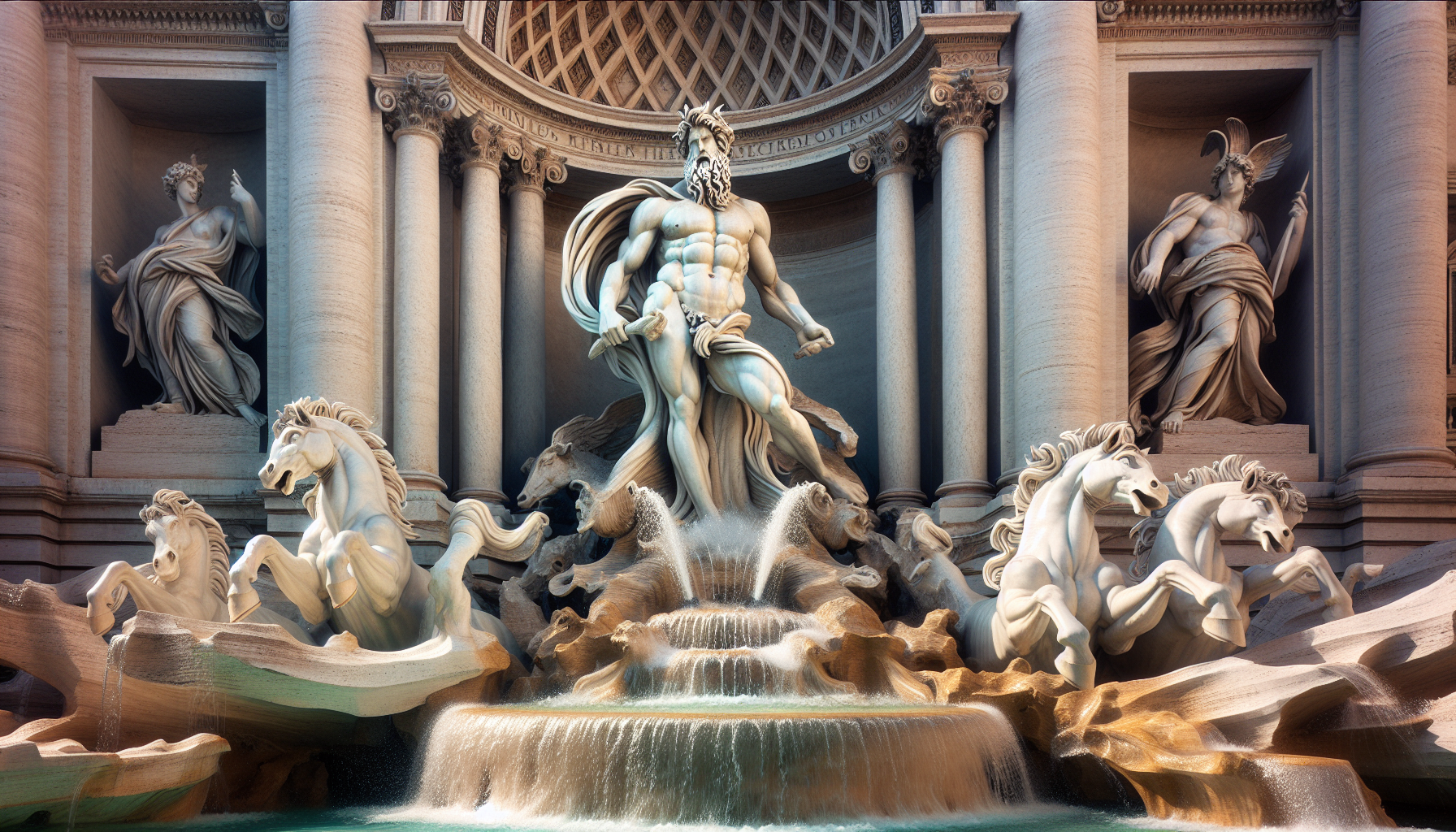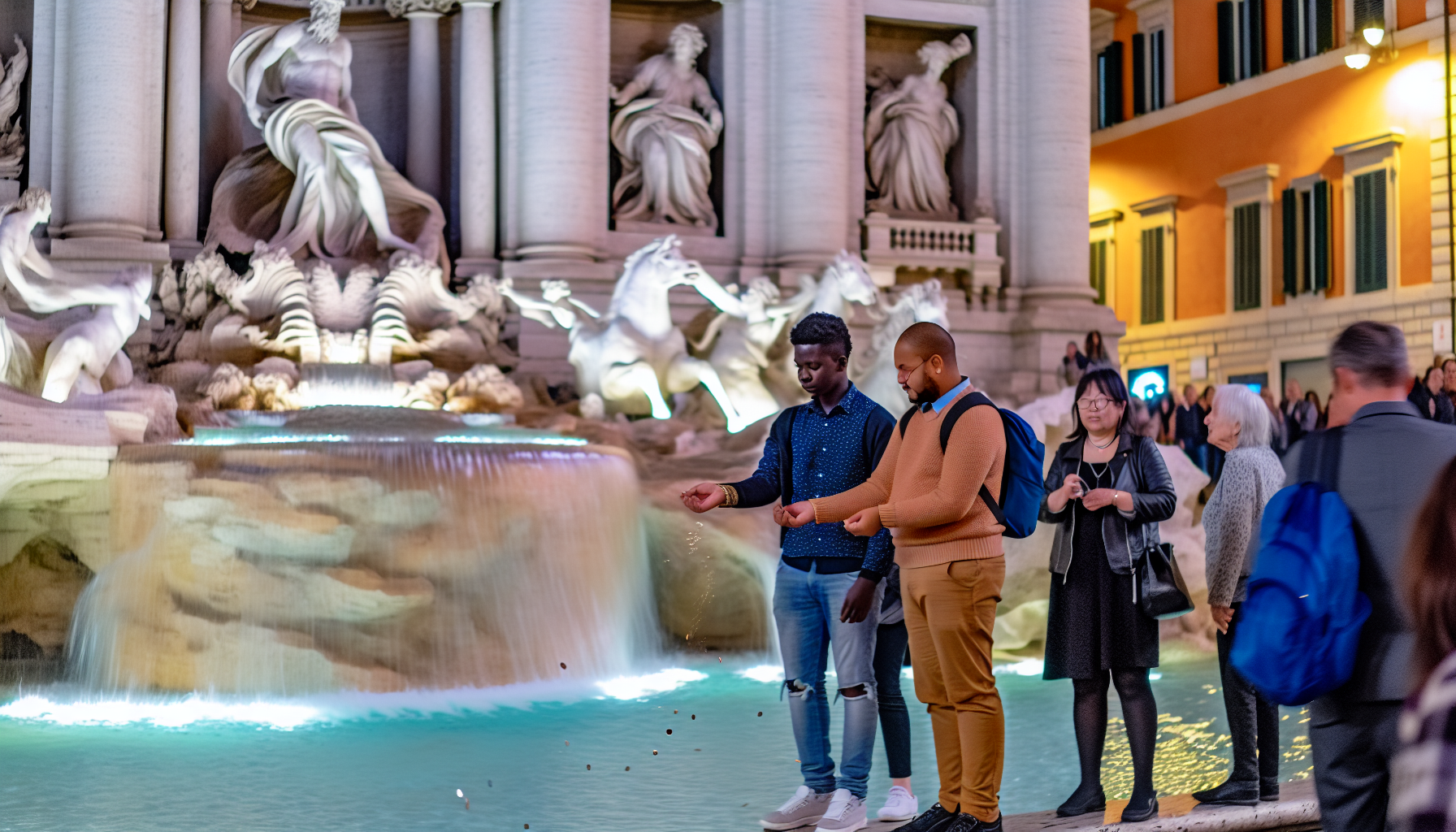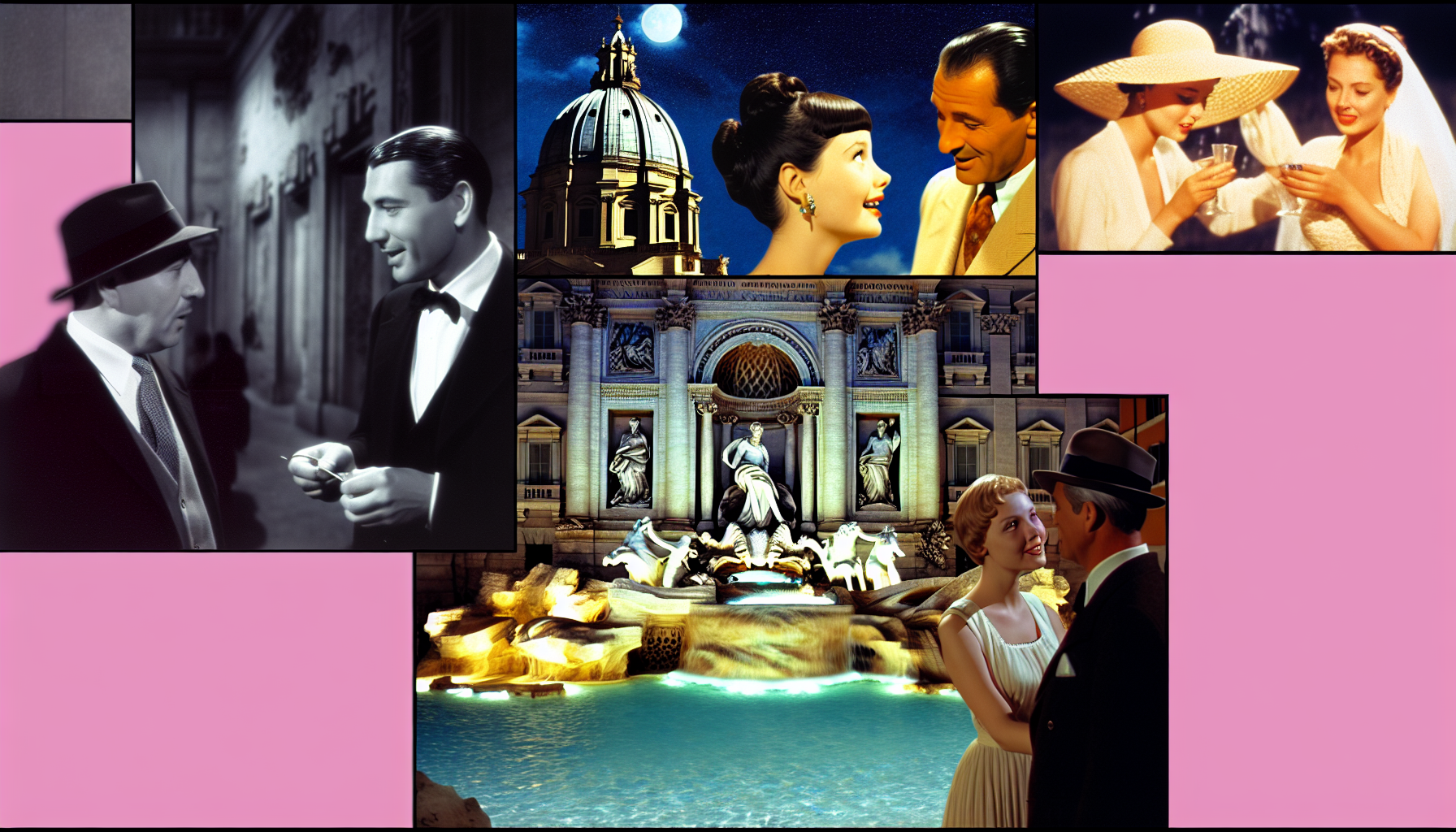Immerse yourself in the enchanting world of Rome, a city where history and art intertwine in a dance of timeless beauty. At the heart of this dance is the Trevi Fountain, a stunning testament to Rome’s enduring allure.
Key Takeaways
- Discover the majestic Trevi Fountain, tracing its origins to 19 BCE and symbolizing Rome’s architectural and artistic prowess.
- Explore the fountain’s intricate iconography featuring Greek gods, tritons, and winged horses that celebrate water in ancient Rome.
- Experience the beauty of this iconic landmark with tips such as visiting at dawn or evening, using public transportation options for easy access & avoiding swimming or coin fishing, as they are illegal activities.
Unveiling the Origins of Trevi Fountain

Standing majestically at the intersection of three streets, or ‘tre vie,’ Rome’s Trevi Fountain, also known as the Rome Trevi Fountain, Fontana di Trevi, or La Fontana di trevi, is an integral part of Rome’s historical and cultural fabric. Its origins trace back to the endpoint of the Aqua Virgo Aqueduct, an ancient water source vital to the city’s sustenance. As a testament to its historical significance, the Trevi Fountain serves as a reminder of Rome’s rich past and the importance of water in the development of the city. The Trevi Fountain stands as a symbol of Rome’s architectural prowess and artistic heritage.
This majestic baroque fountain, crafted from travertine stone, has become a famous fountain and symbol of the city’s artistic legacy, capturing the evolution of Rome’s history in its intricate carvings.
The Aqua Virgo Aqueduct
Constructed in 19 BCE, the Aqua Virgo Aqueduct was a lifeline for the city of Rome. Named after a generous virgin who guided parched soldiers to the source of its spring, this ancient aqueduct was designed to channel the essence of life – water – into the heart of the city.
Today, it continues to feed the Trevi Fountain, a testament to the enduring ingenuity of ancient Roman engineering.
The Legend of the Beautiful Virgin
The legend of the beautiful virgin adds a layer of mystique to the Aqua Virgo Aqueduct and, by extension, the Trevi Fountain. The story tells of a young girl who led thirsty Roman soldiers to a spring, which became the source of the aqueduct. This tale not only gave the aqueduct its name but also symbolizes the unwavering love and dedication to the city that the Trevi Fountain encapsulates.
The Masterminds Behind the Fountain’s Design

The grandeur of the Trevi Fountain is a testament to the artistic genius and engineering prowess of its creators. Its design evolved over time, with contributions from some of the most revered names in architecture and art.
The initial vision was provided by Bernini, followed by the winning design from Nicola Salvi and the final touches from Pietro Bracci.
Bernini’s Initial Plans
Bernini’s initial plans for the fountain were conceived under the patronage of Pope Urban VIII. The pope desired to renovate the fountain, but his death led to the project’s abandonment. However, Bernini’s vision was not entirely lost. His ideas of crafting a symbolic gesture of a visitor’s desire to return to Rome heavily influenced the fountain’s design.
The first coin thrown into the fountain, as per Bernini’s design, signified a commitment to revisiting the historic city.
Nicola Salvi’s Winning Design
Nicola Salvi, an esteemed Roman architect, won the competition to design the Trevi Fountain, forever leaving his mark on Rome’s landscape. His magnificent design breathed life into the fountain and laid the foundation for its iconic status. Salvi began constructing the fountain in 1732 but sadly passed away before its completion.
Pietro Bracci’s Completion
The task of completing the Trevi Fountain fell to the gifted sculptor Pietro Bracci. Bracci added the imposing statue of Oceanus, the Greek sea god, in the central arch, bringing the fountain’s design to fruition. His work on the Trevi Fountain was a testament to his artistic skill and played a significant role in shaping the fountain’s final appearance.
Decoding Trevi Fountain’s Iconography

The Trevi Fountain is a visual feast adorned with numerous sculptures, each teeming with symbolism. From the Greek sea God Oceanus to Tritons and winged horses, the fountain’s iconography weaves a rich tapestry of myth and legend.
Adding to this intricate narrative are the statues of Abundance and Health: Celebrating Water’s Life-Giving Role, highlighting the importance of water in ancient Rome.
Oceanus: Greek Sea God
Oceanus, the central figure of the Trevi Fountain, personifies the authority and power of water. As the Greek sea god, he is often depicted as a river encircling the Earth in Greek mythology. In the fountain, he is seen riding a shell-shaped chariot, signifying his dominion over all water bodies.
Tritons and Winged Horses
The fountain’s design also incorporates tritons and winged horses, artistically symbolizing the fluctuating moods of the sea. The contrasting demeanor of the horses – one calm and the other agitated – captures the unpredictable nature of water, adding depth to the fountain’s narrative.
Abundance and Health
Flanking the central arch of the Trevi Fountain are statues representing Abundance and Health: Celebrating Water’s Life-Giving Role. These figures underscore the importance of water in sustaining life and prosperity.
The statue depicting a horn of plenty aligns with the goddess Abundance, a representation of mythological and allegorical figures, while an urn on the right edge signifies health.
Coin Tossing Rituals and Legends

A visit to the Trevi Fountain is incomplete without participating in the iconic tradition of coin tossing. This ritual, steeped in legend and hope, enriches the fountain’s allure. Whether it’s a pledge to return to Rome, a wish for romance, or a prayer for marriage, each coin tossed into the fountain carries a tale of its own.
The Symbolism of Tossing Coins
The act of tossing a coin into the Trevi Fountain is more than just a tourist tradition. It is steeped in symbolism, with the belief that throwing a coin ensures the traveler’s return to Rome. This ritual, performed with the right hand over the left shoulder, is a pledge of commitment to revisit this historic city.
The Three Coin Legend
Adding to the charm of this tradition is the Three Coin Legend. It is believed that throwing one coin guarantees a return to Rome, two coins lead to a new romance, and three coins ensure marriage. Each coin tossed into the Trevi Fountain thus carries a promise and a hope.
Charitable Donations
The coins you toss into the Trevi Fountain also serve a noble cause. These coins are collected and donated to charity, ensuring that your wishes help those in need. Each year, millions of euros are collected from the fountain and used to enhance and reconstruct the city’s historical infrastructure.
Trevi Fountain on the Silver Screen

The Trevi Fountain’s iconic status extends beyond its physical location, reaching into the realm of film. Its mesmerizing beauty has graced the silver screen in numerous films, including the timeless classics “La Dolce Vita,” “Roman Holiday,” and “Three Coins in the Fountain.”
Each cinematic appearance of the Trevi Fountain, one of the most famous fountains, further cements its place in popular culture.
Restoration and Preservation Efforts
Preserving the historical and artistic integrity of the Trevi Fountain is of utmost importance. Over the years, multiple restoration and preservation efforts have been undertaken to ensure that future generations can also marvel at its grandeur.
The most recent restoration was generously funded by the luxury fashion brand Fendi and included the installation of LED lights to enhance the fountain’s appearance.
Fendi’s Contribution
Fendi, a renowned Italian fashion house, made a significant contribution to the Trevi Fountain’s restoration in 2015. Recognizing the importance of preserving this iconic landmark, Fendi provided the funds necessary for a comprehensive restoration effort.
LED Lighting Installation
The restoration project involved the addition of more than 100 LED lights. This will amplify the nighttime beauty of the fountain. These lights not only showcase the fountain’s intricate details but also contribute to the enchanting atmosphere it exudes after dusk.
Future Preservation Plans
The preservation of the fountain extends beyond its recent restoration. Ongoing efforts aim to counteract the effects of climate change, pollution, and aging infrastructure to maintain the fountain’s structural and artistic integrity.
Visiting the Trevi Fountain: Tips and Tricks
A visit to the Trevi Fountain is a must on any trip to Rome. Whether you are drawn by its artistic grandeur, fascinating history, or the allure of its coin-tossing tradition, here are some tips and tricks to enhance your experience.
Ideal Times for Visiting
The Trevi Fountain is a popular attraction, drawing crowds throughout the day. To soak in its beauty without the bustling crowds, consider visiting at dawn or during the evening.
The fountain is particularly enchanting in the soft glow of the morning sun or under the ambient illumination of its LED lights.
Nearby Attractions
The fountain’s central location makes it a perfect starting point for exploring other historical landmarks. Just a short walk away, you’ll find iconic attractions such as the Pantheon, Piazza Navona, and the Spanish Steps.
Public Transportation Options
Reaching the Trevi Fountain is easy, thanks to Rome’s well-connected public transportation system. The Flaminio and Barberini metro stations are within comfortable walking distance, and several bus routes pass by the fountain. Alternatively, a scenic walk from Termini station is a wonderful way to discover Rome’s charm while heading to the fountain.
The Legalities of Swimming and Coin Fishing
While the allure of the Trevi Fountain may tempt you to dive in or scoop up a keepsake coin, it’s important to respect the local laws. Swimming in the Trevi Fountain is strictly prohibited, and fishing coins out of the fountain can result in hefty fines.
Exploring Rome’s Other Fountains
Rome is a city of fountains, and while the Trevi Fountain is a highlight, the city has many other stunning fountains to explore. Each with its own unique artistry and story, these fountains offer glimpses into Rome’s rich history and culture.
From the Fountain of the Four Rivers to the Turtle Fountain, Rome’s famous fountains are awaiting your discovery.
Summary
Rome’s Trevi Fountain is a testament to the city’s rich history, artistic brilliance, and enduring allure. From its origins tied to the Aqua Virgo Aqueduct to its cinematic appearances, every aspect of the fountain tells a story. Whether you’re tossing a coin into its waters or admiring its Baroque artistry, a visit to the Trevi Fountain is a journey through the heart of Rome.
Frequently Asked Questions
What was Trevi Fountain for?
The Trevi Fountain is one of the oldest water sources in Rome, with its construction dating back to 19 B.C. when the Aqua Virgo Aqueduct was built to provide water to Roman baths and fountains.
How much money gets thrown into the Trevi Fountain?
Every day, around $3,500 worth of coins are thrown into the Trevi Fountain, amounting to an annual donation of $1.7 million to the Catholic charity Caritas since 2001.
What is so special about the Trevi Fountain?
The Trevi Fountain is a marvel of modern engineering, built in the 1700s using the same travertine stone as the Colosseum. Its impressive presence serves as a reminder of Rome’s rich history and culture.
What is the myth of the Trevi Fountain?
The myth of the Trevi Fountain states that if you throw one coin into the fountain, you will return to Rome, two coins ensure you’ll return and fall in love, and three coins mean you’ll return, find love, and marry. This myth originated in 1954 with the movie “Three Coins in the Fountain.”
What is the best time to visit the Trevi Fountain?
The best time to visit the Trevi Fountain is at dawn or in the evening to enjoy a peaceful and less crowded experience.
What happens if you throw a coin in the Trevi Fountain?
The first and most well-known reason is based on local lore, stating doing so will bring you back to Rome again someday. But the next two reasons are lesser-known: to find love or romance while in Rome and to happily marry there.
How much money is thrown into Trevi Fountain daily?
Coins are purportedly meant to be thrown using the right hand over the left shoulder. This was the theme of 1954’s Three Coins in the Fountain and the Academy Award-winning song by that name, which introduced the picture. An estimated 3,000 euros are thrown into the fountain each day.
How often do they empty the Trevi Fountain?
Cleaning happens on Mondays and Fridays, starts at 8 am, and takes a couple of hours. Each year, approximately 1.5 million Euros are collected from the fountain and donated to local charities.
